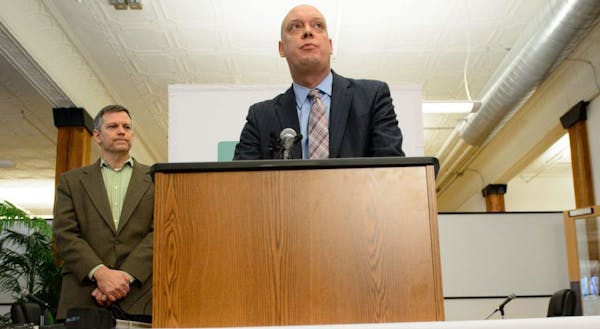As problems with Minnesota's health insurance exchange website persist, MNsure board members on Wednesday for the first time raised questions about the competency of the outside companies the state hired to build it.
"Did we pick the wrong vendor?" Minnesota Department of Human Services Commissioner Lucinda Jesson asked.
"You put in one fix, and it causes two others," she added. "At what point do we say, 'We can no longer try and fix this; we need to bring in someone else.' "
With a Monday deadline looming for consumers to sign up for coverage, MNsure board Chairman Brian Beutner deferred a serious discussion on outside vendors until January, but he said Jesson raised a legitimate issue.
"How long do we give them?" Beutner said.
Four companies have played key roles in building the MNsure site, with the Reston, Va.,-based company Maximus serving as the lead contractor. The state received $46 million in federal grants to build the complex technological infrastructure and has paid Maximus a little more than $25.4 million to date, MNsure officials said.
Minnesota hired Maximus because it "came with a whole package," former MNsure executive director April Todd-Malmlov told the Star Tribune this summer. That included established relationships with the three companies it hired to do the heavy lifting on the IT side — Connecture of Brookfield, Wis.; IBM's Curam Software and EngagePoint of Fort Lauderdale, Fla.
Maximus is a $1.2 billion publicly traded company that runs call centers and administers government programs in the United States, Canada, Australia and Saudi Arabia. The company has worked on five other state exchanges and has a hand in running call centers in states that are using the federal exchange at healthcare.gov.
Maximus declined to comment for this story.
Minnesota officials have insisted that the IT contract with Maximus is the smallest among the states that are building a system they intend to run and not outsource. The contract had stipulations to withhold money if certain benchmarks were not met, and the state has held back nearly $3.3 million to Maximus, MNsure officials said.
Under MNsure's hood, more than 40 software programs are running to keep data private, verify a person's identity and connect with the state's computerized system that enrolls citizens in publicly subsidized health plans, Medical Assistance and MinnesotaCare.
"This was the most aggressive IT project I've seen in my 32 years," said Tom Baden, a longtime employee of the Department of Human Services who works closely on the project for the state's IT department.
Inflexible deadline
Baden said it has been an unprecedented effort that involves coordination with multiple state agencies and highly technical issues that span network connections and security.
Original plans for the system became hobbled by delays at the federal level in handing down much-needed rules and an immovable Oct. 1 deadline to get it launched. Upgrades are in the works.
"We had nine months to bring this thing home," Baden said. "We had to pare down a number of functions ... and we were working 12-, 14-, 16-hour days."
The subcontractors have been responsible for building the portion of the website used by consumers, interacting with a federal hub to verify citizenship and eligibility for tax credits, collecting premiums and making sure insurance companies get paid.
Todd-Malmlov, who resigned Tuesday, said the state saved money because the same team of companies was also working on the Maryland exchange, though in different capacities. The two states would be able to learn from each other, she told the board.
But Maryland's exchange also has been caught up in glitches and turmoil. That state's executive director, Rebecca Pearce, resigned from her post Friday over ongoing technical problems and revelations that she spent Thanksgiving in the Cayman Islands, out of reach from e-mail, phones and text messages.
Hawaii's exchange leader has also resigned, and Oregon's has taken a leave of absence.
By all accounts, crushing deadlines and lack of direction from the White House dogged the process, as the rollout of the Affordable Care Act became embroiled in politics and criticism of the law.
With all hands on deck to make sure that those who need coverage on Jan. 1 will have it, the focus is on putting manual processes in place, getting software upgrades in place and doing additional testing.
The state is setting up 200 workstations in less than 24 hours for additional help.
Jackie Crosby • 612-673-7335
What a TikTok ban in the US could mean for you
A conservative quest to limit diversity programs gains momentum in states
What to listen for during Supreme Court arguments on Donald Trump and presidential immunity

